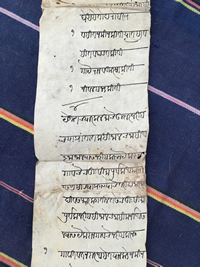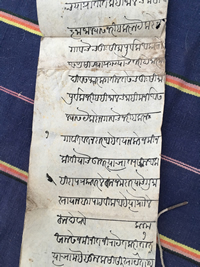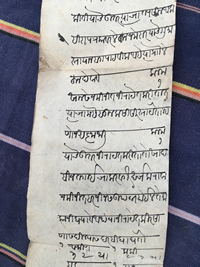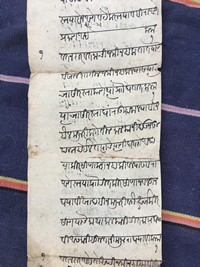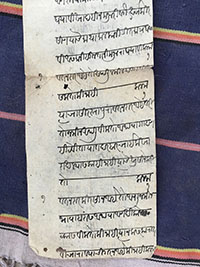Memorandum containing answers to queries about agriculture and revenue collection in district Dhar
This memorandum provides a list of answers to queries about agriculture and revenue collection in district (pargana) Dhar regarding types of land, terms of land tenure, expenses for cultivation, and sale of land holdings. It is a document fragment.
Functional document type: Administrative Records
Formal document type: Yadi
Themes: Agriculture, Records, Taxation and Tribute
Date:
Suhur calendar: Shaʿban 1220
Fasli calendar: 1227
Gregorian calendar:
1820
[Page 1r]
invocation (top centre): Marathi
श्री
Shri
main text: Marathi
1यादी कलमबंदी
नाल शाहून अली
त्याचा
2जवाब प्रगणे धार
सु||
अशरीन मया-
3तैन व अलफ
सन
१२२७ माहे साबान उर्फ
4अधीक जेष्ठ मास
5४ कीता
6१ गावचा रकबा कीती हांजार बी-
7घे आहे तो दरोबस्त
8१ वहीत जमीन कीती त्यात हली व-
9हीत व पडत कीती
10१ गायरान व कुरण कीती
11१ निवल बजड [बंजर] कीती
[Page 2r]
12--
13४
14येकूण च्यार कलमाचे उतर जरीबा
15चया प्रांतात कधी जालेच नाही आ-
16ज्ञा जाल्यास जरीब करून येक दोन
17गावचे चतु:सीमापूर्वक
[आकारा[स]]
18आणू सार्या प्रगण्याचे तरी होनार
[नाही]
19दिवस फार लागतील तसे चतु:सीमा-
20पूर्वक जरीबही जालेच नाही मर्जी अस-
21ल्यास येक दोन गावाचे जरीब करू न
22१ गावात वतनदार आहेत याजकडे जमीन
[Page 3r]
23कीती याचे उतर त्याचा तपसील अला-
24हीदा पत्रकावर लेहून जमेदार याचे गुमा-
25स्ता याज ब|| पाठवीला आहे त्या प्र|| ले-
26हून देवावे ___ कलम १
27खालसे जमीनीत जीरायेत करीतात
[Page 4r]
28त्याचा महसूल कसा सीरस्ता येतो म्ह-
29णोन आज्ञा जाली ___ कलम १
30याचे उतर जीरायत करीतो तो खाद
31बीज तगाईचा कर वगैरे खर्च करावा
32जमीनीत हर जीनस उपन्न [उत्पन्न] होईल ते मा-
33कानी घ्यावे अथवा जिरायेत कीरसा-
34णास दील्यास दर बीघा घेतो
[Page 5r]
35१ अफीण १ मकी [मका]
36३
२
२||
२
३
२||
37बाड १ गहू
38३
२
२|
.॥।
१
39१ वतनदार याजकडे जमीनी आहेत त्याचा
40अमल देतात की नाही ___ कलम १
41याचे उतर सीरस्ता तीसरे वर्ष पेशकसी
42म्हणोन मोघम बीघ्याचे रुपया रीत व-
43हीत जमीनीवर घेतात या प्र|| चाल या
44प्रगण्यात आहे ___ कलम
45१ इनामदार जमीनीचे काही सरकारात देता-
[Page 6r]
46त की नाही ___ कलम १
47याचे रीत सरकारात मालकाकडे
[शाहीब्या-
48हा]
जाला असता फाला असामी पाहून करीतात
49१ पायगस्तीने दर गाववाले कीरन जमीन
50हाकतात त्याचा सीरस्ता ___ कलम १
51याचा सीरस्ता गावात दर बीघा येक रूप-
52या
साहा आणे व पायागस्ती
सीरस्ता येक
53रुपया
दोन आणे व येक रुपया व बीरा [बारा] आणे
54प्रमाणे आहे ___ कलम १
55१ वतनदार वतनाची जमीन हाकतात याचे
[Page 7r]
56व खालशातील जमीन हाकल्यास त्या-
57चा सीरस्ता कोणत्या प्र|| घेतात कलम १
58त्याचा सीरस्ता घांराऊ हाकल्या बीज
59बैल मजुरी लागेतील मालकानी देऊन उ-
60पन्न [उत्पन्न] होईल ते त्याचे त्याणी घ्यावे अथ-
61वा कीरसाणाकडोन हाकीवल्यास बारा
62आणे रुपया प्र|| रीत कीरसाणाजवलून
63घ्यावी खाद बीज मजुरी वगैरे खर्च कीर-
64साण याचे माथा मालकानी रीत मात्र घ्या-
65वी असमानी सुलतानी मजुरा घ्यावी कलम १
[Page 8r]
66१ वतनदार आहे तो आपली जमीन हाकू विकू
67सकतो की नाही ___ कलम १
68त्याचा सीरस्ता पुरा वतनदार आहे तरी
69तो जमीन आपली विकतो अथवा गाहाण-
70ही ठेवीतो यात दरबारचा ईलाखा
71दाखल्यास काही नाही त्याचे खुसीने करी-
72तो ___ कलम १
73१ वतनदार कीरसाण आहे तो आपली जमीन
74भावाबंदास अथवा आणखी को-
75ठल्यास विकतो की नाही त्याजला सरकारात
76वीचाराव्याची गरज आहे की नाही कलम
1Yadi written in articles [by] Nal Shahun Ali, [containing] his
2answers for the pargana Dhar in the Suhur year twenty, two
3hundred and one thousand [i.e. 1220], or the year 12271 in the month of Shaʿban, or
4Adhik Jyeshtha
54 items
61 How many thousands of bighas are
7part of the grounds of the village in total?
81 How much land is cultivated, and within that, today
9how much is cultivated and fallow?
101 How much pasture and grassland?
111 How much is merely wasteland?
12--
134
14In total, answers to the four articles [by way of] a land survey
15in the prant has never happened.
16If ordered, we will carry out a land survey, and one or two
17villages’ estimates according to their four boundaries
18will be taken. [However] the whole pargana’s will not happen.
19It will require many days so a boundary-wise survey
20has never happened. If it will please,
21we will carry out the survey of one or two villages.
221 How much land do the watandars in the villages have?
23In answer to this, details on a separate
24paper have written, and via the jamadar’s
25agent, have been sent.
26According, write this. ___ Article 1
27In the khalsa lands, they conduct agriculture.
28In what manner does its revenue come in? So it
29it is ordered. ___ Article 1
30In answer to this, [whoever] does agriculture,
31deducts advances for seeds, provisions, and other expenses.
32Every good that will be produced out of the land
33will be taken by the landlord or if given to the cultivator,
34[from] each bigha will be taken
351 opium 1 corn
363 2 2½ 2 3 2½
37pulses 1 wheat
383 2 2¼ ¾ 1
391 Are the lands held by the watandars governed [taxed]
40or not? ___ Article 1
41In answer to this, the procedure [is that] in the third year, a pishkash,
42meaning a general sum according to the rupee system,
43on the cultivated lands is taken. So is the practice
44in the pargana. ___ Article
451 Do the inʿamdars of the lands give anything to the government
46or not? ___ Article 1
47The custom is that if a landlord has acquired a command [post]
48in the government, people look to take shares.
491 [Regarding] those non-residential tenants who work the land,
50[what is] the procedure? ___ Article 1
51The procedure [is that] in the village, [on] each bigha one
52rupee, six annas and the procedure [for] non-residential tenancies, one
53rupee, two annas and one rupee and twelve annas;
54so is [the procedure]. ___ Article 1
551 [Regarding] the watandars who work their patrimonial lands
56and if khalsa lands are worked,
57by which procedure are [revenues] taken? ___ Article 1
58The procedure [is that] if household [lands] are worked, seed,
59buffaloes, and wages for laborers will be required. The landlord will give,
60and he should take his [share] from the resulting yield, or
61if they are worked through a cultivator, twelve
62annas according to the rupee system from the cultivators
63used to be taken. Seed, provisions, wages, and various other expenses
64by sheer custom used to be taken by the landlord [on] the head of the cultivator.
65They used to take deductions on account of the actions of heaven and king.2 Article 1
661 Are the watandars able to sell their lands
67or not? ___ Article 1
68The procedure [is that] even if one is a full watandar,
69one sells or pawns one’s land.
70The court has no claim over
71that whatsoever. He does so
72at his pleasure. ___ Article 1
73If the watandar who is a peasant
74sells his land to his kinsmen or anyone else
75does he need to ask the government
76[for permission] or not? Article
Notes
1. 1227 appears to be a Fasli year; however, it does not correspond to the Suhur year 1220 written earlier in the document using terms derived from the Arabic words for numbers. Whereas Shaʿban 1227 converts to June/July 1817 of the Gregorian calendar, Shaʿban 1220 yields a date of May/June 1820. The document also references the Hindu intercalary month Adhik Jyeshta, which is inserted to reconcile lunar and solar modes of reckoning time. Within the period in question, the months Adhik Jyeshta and Shaʿban coincided at the end of the Suhur year 1220; hence, we determine that the document is most accurately dated to May/June 1820. [BACK]
2. The phrase is asmani-sultani, meaning any unforeseen disaster caused by divine or secular power, such as a drought or an invasion. [BACK]
memorandum
district
a measure of land, corresponding to between 1600 and 3200 acres depending upon the region
province
district
landlord holding a special non-transferable revenue assignment
commander of a body of troops
a measure of land, corresponding to between 1600 and 3200 acres depending upon the region
landlord holding a special non-transferable revenue assignment
tribute
district
the holder of a grant of tax-free land
a measure of land, corresponding to between 1600 and 3200 acres depending upon the region
landlord holding a special non-transferable revenue assignment
landlord holding a special non-transferable revenue assignment
landlord holding a special non-transferable revenue assignment
landlord holding a special non-transferable revenue assignment
Participants
Language(s)
Marathi
Source
Choudhary Family Collection, Bada Raola Dhar, no shelfmark
Archival Collection: Purshottam Das collection
Transcribed from manuscript image.
Edited by Dominic Vendell
Encoding support and website development by Lizzy Williamson, Eva Bodenschatz, Richard Holding, Julia Hopkin and Gary Stringer

